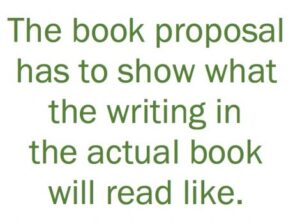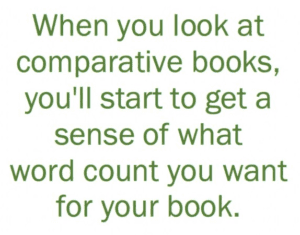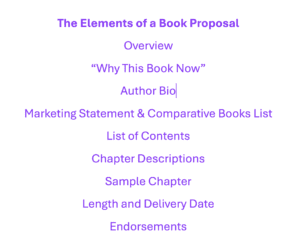THE ELEMENTS OF A BOOK PROPOSAL
To write a book proposal, start with an overview describing the book, why it fills a hole in the marketplace and is needed now, and why you’re the right person to write it. Describe the audience for the book and the benefits your book offers. When describing the audience for the book, you might offer some startling statistics to make the case that your book has a big audience. For example, in the book proposal for Raising a Sensory Smart Child, I wrote, “1 in 20 children has sensory processing disorder: That’s one in every classroom.” In general, statistics such as “Over 20 million people” and “Seventy million Americans” don’t grab people’s attention the way “1 in 20 people” does. Help your book proposal’s reader envision how many people are affected by the situation addressed in your book. If every hour, three people are diagnosed with the condition you are writing about, or if “by the time you finish reading this sentence,” something will have happened, your reader will say, “Wow!”
Alternatively, you might start with an engaging story or series of short anecdotes.
How long should a book proposal overview be? It should be as long as needed to make your case: 2-3 pages or more. Aim to keep your book proposal to no more than 60 pages, with the text double-spaced and in 12-point type in a standard font (such as Times New Roman), without extra lines between paragraphs. Your proposal will have a sample chapter, so be sure to leave room for that. (An agent or editor might want to print out the proposal and make some edits, which is easier when the text is double-spaced. Also, it's easier on the eye to read double-spaced text.)
Some agents and editors will have specific requirements for formatting a book proposal and for its elements. To save time, wait until you get a response from your query letter before changing your book proposal (which you should have completed before querying). Once you get a nibble, it's time to check the agent or publisher's website to see if they have specific requirements for book proposals.
Note that you will want to query literary agents to represent your book project if you want to submit it to editors at the Big 5 book publishers. Many smaller publishing houses don't require you to have a literary agent, however.
Why this book now is a subsection within the overview that sets up the urgency of the need for the book (for example, with a self-help book, the reader has an urgent problem the book aims to solve). Often, authors will introduce themselves in this section and explain why they’re the right person to write the book they’re proposing and how the idea came out of the work they are doing.
An author biography showcases your expertise and offers insights into why you came to do the work you do (speaking about leadership, helping people apply spiritual principles to how they parent their kids, etc.). List any degrees or certifications and descriptions of what you’ve done in the past and include information about your author platform: your foundation for being able to reach out to fans of your work. For example, if you have a podcast, have written articles for magazines and websites, and belong to professional organizations, list those in your author bio. Include any relevant writing experience you have, such as previous books, and identify any major media outlets that have featured reviews of your books or interviews with you.
Include where you reside, too.
Also, you might want to be creative and put a bit of your personality into the author bio, even if it’s just naming your fur babies.
Include a marketing statement. An author platform is key to your visibility and credibility, showing that you have a loyal following that will be eager to buy your book. Include information on your social media followers and activities. An agent or editor will check your social media accounts and website to see whether you have an online presence, how big your online following is, and how engaged your followers are. (I've found with my clients that Facebook is a good social media platform for engaging your followers, so I wrote an eBook on how to make that happen.) Provide links within your book proposal to your author website, blog, and any social media accounts.
In your marketing statement for your book proposal, spell out what you will do to get the word out about the book and to sell copies--for example, you might say that you are planning to hire a social media expert or publicist to help you. Just as you would in a business plan, here you have to convince a professional publisher that your book is a worthwhile investment. Can you get your book announced to a quarter million people via your friends’ and colleagues’ and your email newsletters? Are you planning to do personal appearances you pay for, such as demonstrations at wellness centers and speaking engagements at community centers, bookstores, and churches? Have you done personal appearances? If so, provide details and, ideally, videos that show what a compelling speaker you are.
Offer suggestions for niche media outlets to approach, such as specific types of magazines, websites, podcasts, or blogs that might feature your book in some way. Would your book be of interest to a podcaster whose hook is wellness, people with a chronic condition, people over 50, or something else? Google "top podcasts" and a keyword (wellness, anxiety, over 50, etc.) to find some that might want to feature you and your book and message. If your agent and publisher have worked with authors in your genre before, they know that a press release and an ARC (advanced review copy, a pre-publication version of the book, also known as a bound galley or proofs) needs to be sent to a larger and more obvious outlet, such as Parents magazine. However, they might not know to send these materials to, say, Adoptive Families magazine. They might not be aware of some of the blogs that would let you guest blog or that would interview you or run a Q&A you provide. (In fact, publishers will typically ask you to write up a list of about ten questions and answers that they can send out and that you can feature on your website's book page: Here's an example from my website.)
Specify publicity partners: anyone in your field who will happily announce your book on social media and in their newsletter and blog and interview you or review your book. The idea is to give your publisher a wide range of ideas for promotion.
The marketing statement must include a comparative books list to help the agent and acquisitions editor better understand what books are out there, easily discoverable and selling well. Discoverable could mean they are carried in brick-and-mortar bookstores and online bookstores such as Amazon.com (where 70 to 80 percent of books are sold) and BN.com. It could mean they come up easily in an online search on Amazon or the Internet. (Here's a second article I wrote about comparative books lists that can help you pinpoint why your book stands out from others.)
Write a list of contents for the book followed by an expanded chapter outline (also known as the list of chapter descriptions). Offer at least two paragraphs about what will be included in each chapter. I’ve seen book proposals that sold for six figures that had several pages of description for each chapter, making the proposal longer than 60 pages but irresistible to editors because the descriptions were substantive.
Don’t be vague when describing a chapter’s contents. For example, instead of saying, “Exercises will be included,” or just naming an exercise and leaving your book proposal's reader wondering what that exercise entails, you might say, “In this chapter, readers will discover my Moxie Mama Self-Care Exercise, a guided visualization combined with journaling prompts that help aspiring Moxie Mamas to take better care of their own needs and release any anxiety they have.” Or, you might write, “In this chapter, readers will learn about five keys to being a Moxie Mama when their child is struggling to make friends. They are . . . ”
In the expanded chapter outline, you don’t need to describe any chapters you’re actually including in the book proposal. Instead, just note that the sample chapter is included.
You might put a short sample of material from the actual chapter in one of the chapter descriptions to clarify a point. For example, in my book proposal for Raising a Sensory Smart Child, there was a sample chapter (chapter one) but also a section of sample practical tips to show how that chapter would read. I knew that this particular chapter was extremely valuable for making the book a practical guide, but I also knew that one small section would convey what the entire chapter would look like.
 Provide a writing sample. A book proposal should include your first chapter. Again, consider including a section from another place in the book, too, but it’s usually best not to include the introduction for your book because it will overlap with the overview. Now, I have seen memoir book proposals that sold that did not have an entire sample chapter: The author took short pieces from throughout the memoir and sprinkled them throughout the expanded chapter outline. However, including an entire sample chapter puts you in a safer position with an agent or editor.
Provide a writing sample. A book proposal should include your first chapter. Again, consider including a section from another place in the book, too, but it’s usually best not to include the introduction for your book because it will overlap with the overview. Now, I have seen memoir book proposals that sold that did not have an entire sample chapter: The author took short pieces from throughout the memoir and sprinkled them throughout the expanded chapter outline. However, including an entire sample chapter puts you in a safer position with an agent or editor.
Specify the length and delivery date, also known as the “specs,” of the book you’re proposing. Within the proposal, either in the overview or in a separate section, you must note when you can deliver the manuscript and what the word count will be. Publishers generally want the book delivered within six to nine months, maximum, although they understand that it will take longer if you’re writing a work requiring substantial research.
 As for length, specify your proposed book’s word count. To calculate the word count of your potential book, look at a book that’s about the size, shape, and length of the book you envision, count the words on a typical page, count the number of pages, and multiply. It’s best to specify word count in contracts, which is much more accurate than citing a page count. If you do a word count on several different books, you’ll see that the number of words that fit on the page depends on the page design (font, “leading” or space between lines, margins, design elements such as boxed texts and sidebars, etc.) Note that a typical length for a self-help book is around 60,000 to 65,000 words or even less. You might quote a range of 60,000 to 65,000 words or 65,000 to 70,000 words. If you don’t know what your book's word count is likely to be, plan it out chapter by chapter. Nine 6500-word chapters = 58,500 words, while twelve 5000-word chapters = 60,000 words. When you look at comparative books, you’ll start to get a sense of what word count you want for your book.
As for length, specify your proposed book’s word count. To calculate the word count of your potential book, look at a book that’s about the size, shape, and length of the book you envision, count the words on a typical page, count the number of pages, and multiply. It’s best to specify word count in contracts, which is much more accurate than citing a page count. If you do a word count on several different books, you’ll see that the number of words that fit on the page depends on the page design (font, “leading” or space between lines, margins, design elements such as boxed texts and sidebars, etc.) Note that a typical length for a self-help book is around 60,000 to 65,000 words or even less. You might quote a range of 60,000 to 65,000 words or 65,000 to 70,000 words. If you don’t know what your book's word count is likely to be, plan it out chapter by chapter. Nine 6500-word chapters = 58,500 words, while twelve 5000-word chapters = 60,000 words. When you look at comparative books, you’ll start to get a sense of what word count you want for your book.
Include endorsements if you can, and even promise a foreword by someone with an impressive name if you can get this commitment from someone in your field. Typically, a foreword is written by another author, a physician or CEO, or some other expert. (Also, make sure you spell “foreword” correctly. A book doesn’t have a forward; it has a foreword.)
If you're ready to write a book proposal, but you'd like some help with your hook, titling, or writing its pieces, contact me at info@nancypeske.com or through my contact form in the menu to let me know more about your book. I typically start working with a client by doing a vision plan call (which includes my sending you a free book proposal template). You can probably complete most of the book proposal on your own with my guidance and assistance to make it as strong as possible—and to have all the elements of a book proposal that can get you a book deal.
